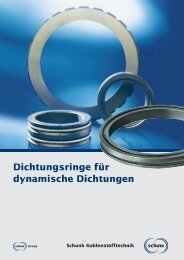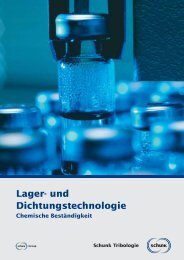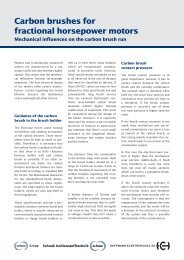Kontakte und Verbindungsteile für die elektrische Energietechnik
Kontakte und Verbindungsteile für die elektrische Energietechnik
Kontakte und Verbindungsteile für die elektrische Energietechnik
Create successful ePaper yourself
Turn your PDF publications into a flip-book with our unique Google optimized e-Paper software.
Beim Ausschalten werden <strong>die</strong><br />
Lichtbogenlöschung <strong>und</strong> der<br />
Abbrand davon beeinflußt, mit<br />
welcher Geschwindigkeit <strong>die</strong><br />
Lichtbögen durch das selbsterregte<br />
Magnetfeld in Löschkammern<br />
abgelenkt werden. Auf reinen<br />
Metallen <strong>und</strong> homogenen Legierungen<br />
wandern <strong>die</strong> Lichtbögen<br />
erheblich schneller als auf Verb<strong>und</strong>werkstoffen<br />
(siehe Abbildung<br />
3).<br />
Bezüglich des Ausschaltabbrandes<br />
können unter Berücksichtigung<br />
der bei verschiedenen<br />
Kontaktwerkstoffen unterschiedlichenLichtbogen-Verharrungszeiten<br />
folgende Werkstoffe als optimal<br />
angesehen werden:<br />
Schaltstrom<br />
10 . . . 100 A AgNi 10<br />
100 . . . 300 A Ag/CdO SP<br />
100 . . . 3000 A Ag/SnO2 SPW<br />
3000 . . . 5000 A Ag/ ZnO SP<br />
> 5000 A Ag/ W, Ag/ WC<br />
When breaking, arc extinguishing<br />
and erosion are affected by the<br />
speed at which the arcs are<br />
deflected into the arc chutes by<br />
the self-excited magnetic field.<br />
The arcs migrate much more<br />
quickly on pure metals and<br />
homogeneous alloys than on<br />
composite materials (see figure 3).<br />
With respect to arc erosion<br />
on break, the following materials<br />
can be regarded as the best, taking<br />
into account the varying arc<br />
staying times for different contact<br />
materials:<br />
Switching current<br />
10 . . . 100 A AgNi 10<br />
100 . . . 300 A Ag/CdO SP<br />
100 . . . 3000 A Ag/SnO2 SPW<br />
3000 . . . 5000 A Ag/ ZnO SP<br />
> 5000 A Ag/ W, Ag/ WC<br />
Cu<br />
AgCu<br />
Ag<br />
AgNi 10<br />
Ag/CdO 90/10 i. ox.<br />
AgNi 20<br />
AgNi 30<br />
AgNi 40<br />
Ag/SnO 2 90/10 SPW<br />
Ag/CdO 90/10 SP<br />
Ag/SnO 2 88/12 SPW<br />
Ag/CdO 85/15 i. ox.<br />
Ag/CdO 88/12 SP<br />
Ag/W, Ag/WC<br />
Ag/C<br />
14<br />
Abbildung 3<br />
Figure 3<br />
Illustration 3<br />
A la mise à l’arrêt, l’éxtinction des<br />
arcs et l’érosion sont affectés par<br />
la vitesse à la quelle les arcs sont<br />
déviés dans la chambre d’éxtinction<br />
par le champ magnétique<br />
autoexité. La migration des arcs<br />
est beaucoup plus rapide sur des<br />
métaux purs et homogènes que<br />
sur des pseudoalliages (voir illustration<br />
3).<br />
En ce qui concerne l’érosion<br />
engendrée par l’arc lors de l’ouverture<br />
des contacts, les matériaux<br />
suivants peuvent être considérés<br />
comme étant les meilleurs,<br />
et ce en tenant compte des diverses<br />
durées des arcs ainsi que des<br />
différents matériaux de contact :<br />
Courant de commutation<br />
10 . . . 100 A AgNi 10<br />
100 . . . 300 A Ag/CdO SP<br />
100 . . . 3000 A Ag/SnO2 SPW<br />
3000 . . . 5000 A Ag/ ZnO SP<br />
> 5000 A Ag/ W, Ag/ WC







